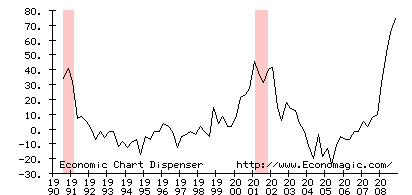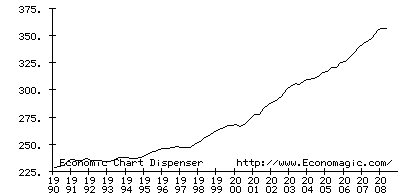
By now we know the story all too well. Sixteen strangers debark onto a jungle island and are told they must work together to survive. While they pretend they’re on the same team, from the start they scheme to position themselves to outlast the other contestants, because at the end of the day they know there will only be one SURVIVOR.

% of Banks Tightening Standards for Small Firms Seeking Loans (Shading denotes recessions)
Every business leader in America (and the World for that matter) is anxious to understand the impact of the financial crisis on their own business and personal prospects. How bad is it going to be? Does the crash present new opportunities? What should I do now? And yes, “What must I do to survive?”
Based on conversations with our clients and with financial and strategic investors, many are choosing to “hunker down” and ride out the storm. For some firms this may be an appropriate course. Yet to make such a decision without a realistic evaluation of your firm’s financial survivability in light of the new circumstances would be shortsighted at best.
Unless you have capital reserves sufficient to weather a very protracted (perhaps eighteen months or more) and severe downturn, your business could be at grave risk. And if you depend on leverage, this calculation must also take into account the potential impact of reduced loan availability and dramatically higher loan pricing, which may well come sooner than you expect.
What We Know
The U. S. economy is in the midst of what will likely be the worst recession in the postwar era. It appears that the decline is rapidly spreading around the world and that we may well experience a serious global recession that will dramatically affect even the (until now) rapidly developing economies of Asia and Latin America as well as the developed world.
The effects of this recession are expected to impact the economy through much of 2009 and possibly beyond. While all eyes are now on housing, autos and consumer goods, which have rapidly declined in recent months, other industries will be impacted soon.
The financial crisis is far from over. The Treasury has put a Band-Aid on the banking industry with its $250 Billion preferred stock investment and the Fed has already provided over $1.5 Trillion dollars in new liquidity to the financial system worldwide to free up the frozen capital markets since March 2008, with much more to come. (For more information on the explosion of the Federal Reserve balance sheet see the excellent chart maintained by Cumberland Advisors at www.cumber.com/home/Factors.pdf).
To date, the worldwide financial industry has experienced $684 Billion in losses from financial asset write downs, primarily from sub-prime and other improvidently granted mortgages and these losses have been replaced with $690 Billion in new capital from private investors, sovereign wealth funds, and, increasingly, from government bailout investments in the U. S. and Europe (see chart at http://seekingalpha.com/article/103330-global-writedowns-vs-capital-raised).
What has not yet been addressed are a number of asset classes that have until now held up reasonably well, but which will almost certainly witness increasing write-offs in the coming months. These include:
- The leveraged loans that funded the buyout boom of 2004-2007.
- Alt-A and even traditional mortgages that are increasingly under water as home prices continue to decline.
- Credit cards.
- Auto loans.
- Land, Development, and Construction loans.
- Commercial real estate loans.
Nouriel Roubini, among the most pessimistic, but also among the most accurate observers of the current economic scene, recently has predicted that, before the crisis is over, worldwide write-downs by the financial industry will total $2 Trillion. This almost guarantees a dramatic reduction in credit worldwide over the next 18-24 months.
In Q2 2008 total public and private debt in the United States was almost 3.6 times Gross Domestic Product, well over twice the level just prior to the Great Depression. By comparison, this ratio was 2.6 ten years ago at the time of the world’s last major credit crisis.

Total Credit Market Debt as a Percent of GDP
(An excellent, but somewhat dated longer term chart of the same data from Ned Davis Research can be found at http://www.comstockfunds.com/files/NLPP00000/292.pdf). Since then, the U.S. financial system has created unprecedented levels of leverage, making the economy much more susceptible to economic shocks such as the one we are now experiencing. The current economic pain is not likely to end until this burdensome debt is significantly reduced in a process euphemistically called “deleveraging.”
So What Does this Mean for Me as a Business Owner?
Joseph Schumpeter, the great Austrian economist, popularized the idea of “creative destruction” as one of the great engines of progress inherent in the capitalist system. When you’re on the receiving end there is nothing creative about it. It’s just destruction. Just ask one of the thousand auto dealers expected to go out of business this year.
In the short term, one of the primary sources of pain for business owners will be the banks. The chart at the beginning of this article tells the story. From 2005-2007 loan terms and pricing, particularly at the higher end of the market were more liberal than at any other time in the past forty years. The chickens have now come home to roost and we are witnessing a dramatic tightening of loan terms and a sharp increase in pricing.
Loan covenants that permitted debt to cash flow ratios of 4-4.5 times will be renegotiated at 2-2.5 times or less; and pricing spreads are current jumping two to three hundred basis points. This trend will continue, notwithstanding all of the government’s efforts to force easing.
Even more conservatively financed businesses will feel the heat as banks, desperate to improve their risk ratios, squeeze those customers most able to adjust to make up for those that cannot. Companies that are unprepared for the onslaught are at extreme risk over the next six to twelve months.
Given the current challenges, many businesses will not survive. We already are witnessing a dramatic increase in business bankruptcy filings and this is just the tip of the iceberg. Additionally, many other firms will be forced into shotgun mergers as the only alternative to outright failure. To avoid becoming road kill in the panic, companies must act now.
Action Plan for Survival
Deleveraging is going to occur whether or not you plan for it. At the individual business level, deleveraging can come about in several ways:
The Extreme
- Repudiation: in America, the primary tool for business debt repudiation is Chapter 11 and it’s not pretty.
- Negotiation: many creditors understand the value destruction inherent in bankruptcy and are willing to make concessions on the theory that something is usually better than nothing. Often such negotiations will encompass conversions of existing debt into equity ownership, the essence of deleveraging.
The Practical
- Some firms, particularly those that did not succumb to high levels of leverage during the boom, will weather the storm without radical surgery. For those that remain profitable, ongoing accumulation of retained earnings and repayment of debt will reduce leverage over time.
- Even those companies in comparatively good condition must review their current operations and act aggressively to eliminate all unnecessary expenditures.
- Non-core or less productive assets and businesses can be sold to further reduce leverage and build up a reserve for opportunities ahead. Once these disposition opportunities are identified, the owners should act quickly. This is not the time to hold out for top dollar. Values are likely to decline further and those who delay may later find themselves selling the family jewels to survive.
The Necessary
- If a careful evaluation of your company’s financial position leads to the conclusion that your current financing arrangements are not adequate to weather the storm, you should consider raising additional capital as soon as possible. The market for junior (mezzanine) capital remains strong for good companies with proven cash flow, though more expensive than a year ago. Additionally, many banks– particularly community and regional firms that did not get involved in sub-prime lending–are still seeking loans and asset based lenders are available to fill the gap for companies that have strong collateral but an earnings hiccup that makes them unattractive to the banks. Even if you don’t suspect that your bank will pull the plug at renewal time, now is the time to begin looking for alternatives, just in case.
- Sometimes, after a realistic evaluation of your situation, you may conclude that your firm’s chances of surviving a deep downturn are slight. If that is the case, sale of the business may well be the best alternative. Consolidation is the watchword in M&A today. Larger, better capitalized firms will see opportunities to improve their market position through geographical or product line growth. Often these firms can generate profitability, even from acquisition of a money-losing operation at a price in excess of liquidation value, through elimination of duplicative functions and expenditures. Such a sale may not achieve an exit at the price levels seen in 2006-2007, but today’s price will be far better than can be obtained later, after the seller’s operations have felt the full impact of the recession. In any case, a sale today trumps a likely bankruptcy somewhere down the road.
The Home Run
- Tomorrow’s success stories are often born in tough times like these. If your company has financial strength and superior operational capability, now is the time to jump ahead of the pack. Companies will be available for acquisition that you could never have dreamed of buying in the boom, often at distressed prices. Now is the time to put in place an aggressive program to reach out to the market and see what’s available. And unlike in the boom years, you are less likely to be faced with crazily priced auctions and the need to act before you have a chance to do your due diligence. If you play your cards right, you may even be looked upon as a White Knight, ready and willing to lend a hand to companies in a less fortunate situation (but of course at a great price and on favorable terms).
- If you’ve got the skills to grow, but not the bucks, private equity continues to be a good source of the growth capital you will need. Now is the time to establish alliances with potential backers, so that you will be ready to act when the opportunities come along.
At the end of the season, there will be only one SURVIVOR, but there will be fifteen losers. You’re now playing in the toughest game of your business life. Which one will you be?
John Slater is a partner of Focus Investment Banking LLC and a member of its Board of Directors. He has thirty-five years experience working with financially troubled businesses. As Team Leader of Focus’s Financial Alternatives Team, Mr. Slater strives to help companies avoid financial crises through arranging replacement senior financings and junior capital placements. The Financial Alternatives Team also assists with planning and negotiating debt restructurings and the sale or merger of financially troubled firms. This article originally appeared at www.mergers.com/toughtimes














